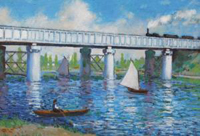 Spot the difference: the 'genuine fake' masterpieces
Spot the difference: the 'genuine fake' masterpiecesJohn Myatt was jailed for forgeries that fooled the auction houses. Now he has a 'genuine fakes' exhibition. Arifa Akbar reports
Friday, 26 September 2008
It began with house paint, KY jelly and scamming of international auction houses, and looked like it would end with a stint inside Brixton prison. Happily for John Myatt, he instead finds himself at Harrods, launching an exhibition of his "genuine fake" masterpieces.
Art aficionados studying the gilt-framed canvas of a view made famous by Claude Monet, in his Impressionist work The Bridge at Argenteuil, might be forgiven for mistaking the painting for the real thing.
On closer inspection, subtle clues suggest the landscape was not painted by the 19th-century master but produced by the deft hand of Myatt, the infamous forger who fooled the world's experts for years before being caught.
From 1987 to 1994, Myatt crafted counterfeit works that were passed off as authentic masters and sold to auction houses such as Sotheby's and Christie's. Before he was imprisoned in 1995, he sold 200 works in the style of Picasso, Van Gogh and Chagall as originals.
On his release after four months – he was known inside as "Picasso" for his portraits of fellow inmates in exchange for telephone cards – he vowed never to paint again. But his arresting officer commissioned a family portrait, and Myatt struggled to put down his paintbrush.
His "genuine fakes" have since received critical acclaim and can sell for five-figure sums. Speaking of his current collection at the Harrods fine art space, Castle Galleries, Myatt, 63, explained his latest style: painting works reminiscent of Gauguin, Modigliani and Giacometti, taking their iconic images as a starting point, but adding his own twist. For one canvas, in the style of Monet, he altered the view which Monet would have seen if he had travelled half a mile along the Seine, to the northwest of Paris, in 1874, where his friend Renoir was painting.
"You could buy one of these and pretend it was an original if you wanted to," he said yesterday. "They are presented similar to the originals, in a gilt frame. In fact, I have one customer in America who has an original Van Gogh hung behind bulletproof glass and he asked me to produce another for him, to hang next to it. None of his visitors has been able to tell the difference."
After training as an art teacher, he moved towards forgery after placing an advertisement in Private Eye for his brushwork services. "I got quite a lot of customers so was able to make a living from home. Someone would give me a family portrait and want me to paint them in the style of Gainsborough or Reynolds," he explained. One such customer kept coming back for more paintings, until one day he told Myatt he had sold a painting in the style of the German Cubist painter Albert Gleizes for £25,000, after a valuation at Christie's. "He reframed it in an old frame and sold it. He gave me half the money. I just couldn't believe it. It was not even painted in oil but in household emulsion softened by KY Jelly."
About 80 of Myatt's fakes are believed to be in circulation, with many owners unaware that they have been the victim of a fraud estimated to be worth several million pounds.
The secret to creating a convincing fake masterpiece, he said, was simple: scrutinise the original time and again. "You 'hypnotise' the original painting, look at the canvas, the thickness of the paint, the way it's presented. The rule applies to anyone from Rembrandt to Picasso, just learn to look at the original, stand in front of it. I have been there for 20 minutes at a time, with my hands behind my back so the gallery attendants don't think you're getting too close. Then I've got into my car with my mental file of it in my head, so I can get home and start working on it.
"The first thing I work on is the composition, once I've got that down I start on the colours and texture – the way the paint leaves the brush." He subsequently spends hours perfecting the artist's signature. At the height of his criminal career in the 1990s, he went to the Tate Modern to "hypnotise" Braque's Seated Nude, and realised he needed a tinted canvas. For Giacometti: "I read around how he painted his nudes, from the head and shoulders and working his way down the body. So that's what I did." He reworked one of Gauguin's girls holding a bowl of fruit, by using the same cheap tarpaulin. More recently, Myatt has been working on a portrait of John Cleese "which he wants in the style of Henri Matisse".
 Spot the difference: the 'genuine fake' masterpieces
Spot the difference: the 'genuine fake' masterpieces